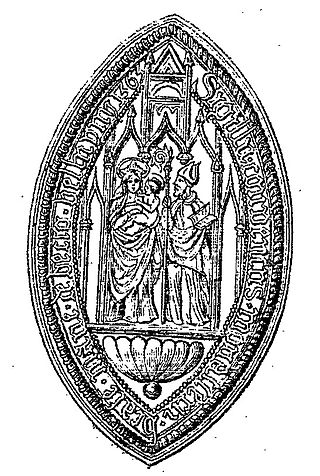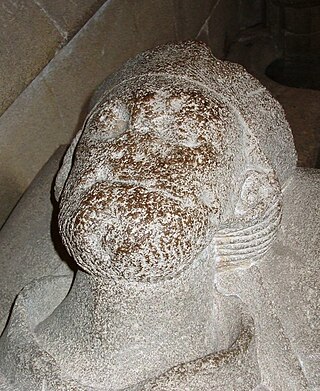
Ealdred was Abbot of Tavistock, Bishop of Worcester, and Archbishop of York in early medieval England. He was related to a number of other ecclesiastics of the period. After becoming a monk at the monastery at Winchester, he was appointed Abbot of Tavistock Abbey in around 1027. In 1046 he was named to the Bishopric of Worcester. Ealdred, besides his episcopal duties, served Edward the Confessor, the King of England, as a diplomat and as a military leader. He worked to bring one of the king's relatives, Edward the Exile, back to England from Hungary to secure an heir for the childless king.
Ælfheah, more commonly known today as Alphege, was an Anglo-Saxon Bishop of Winchester, later Archbishop of Canterbury. He became an anchorite before being elected abbot of Bath Abbey. His reputation for piety and sanctity led to his promotion to the episcopate and, eventually, to his becoming archbishop. Ælfheah furthered the cult of Dunstan and also encouraged learning. He was captured by Viking raiders in 1011 during the siege of Canterbury and killed by them the following year after refusing to allow himself to be ransomed. Ælfheah was canonised as a saint in 1078. Thomas Becket, a later Archbishop of Canterbury, prayed to Ælfheah just before his murder in Canterbury Cathedral in 1170.
Year 1070 (MLXX) was a common year starting on Friday of the Julian calendar, the 1070th year of the Common Era (CE) and Anno Domini (AD) designations, the 70th year of the 2nd millennium, the 70th year of the 11th century, and the 1st year of the 1070s decade.

Lanfranc, OSB was a celebrated Italian jurist who renounced his career to become a Benedictine monk at Bec in Normandy. He served successively as prior of Bec Abbey and abbot of St Stephen's Abbey in Caen, Normandy and then as Archbishop of Canterbury in England, following its conquest by William the Conqueror. He is also variously known as Lanfranc of Pavia, Lanfranc of Bec, and Lanfranc of Canterbury.

Stigand was an Anglo-Saxon churchman in pre-Norman Conquest England who became Archbishop of Canterbury. His birth date is unknown, but by 1020 he was serving as a royal chaplain and advisor. He was named Bishop of Elmham in 1043, and was later Bishop of Winchester and Archbishop of Canterbury. Stigand was an advisor to several members of the Anglo-Saxon and Norman English royal dynasties, serving six successive kings. Excommunicated by several popes for his pluralism in holding the two sees, or bishoprics, of Winchester and Canterbury concurrently, he was finally deposed in 1070, and his estates and personal wealth were confiscated by William the Conqueror. Stigand was imprisoned at Winchester, where he died.
Robert of Jumièges was the first Norman Archbishop of Canterbury. He had previously served as prior of the Abbey of St Ouen at Rouen in Normandy, before becoming abbot of Jumièges Abbey, near Rouen, in 1037. He was a good friend and adviser to the king of England, Edward the Confessor, who appointed him bishop of London in 1044, and then archbishop in 1051. Robert's time as archbishop lasted only about eighteen months. He had already come into conflict with the powerful Earl Godwin and, while archbishop, made attempts to recover lands lost to Godwin and his family. He also refused to consecrate Spearhafoc, Edward's choice to succeed Robert as Bishop of London. The rift between Robert and Godwin culminated in Robert's deposition and exile in 1052.
William de Corbeil or William of Corbeil was a medieval Archbishop of Canterbury. Very little is known of William's early life or his family, except that he was born at Corbeil, south of Paris, and that he had two brothers. Educated as a theologian, he taught briefly before serving the bishops of Durham and London as a clerk and subsequently becoming an Augustinian canon. William was elected to the See of Canterbury as a compromise candidate in 1123, the first canon to become an English archbishop. He succeeded Ralph d'Escures who had employed him as a chaplain.

Bec Abbey, formally the Abbey of Our Lady of Bec, is a Benedictine monastic foundation in the Eure département, in the Bec valley midway between the cities of Rouen and Bernay. It is located in Le Bec Hellouin, Normandy, France, and was the most influential abbey of the 12th-century Anglo-Norman kingdom.

Thomas of Bayeux was Archbishop of York from 1070 until 1100. He was educated at Liège and became a royal chaplain to Duke William of Normandy, who later became King William I of England. After the Norman Conquest, the king nominated Thomas to succeed Ealdred as Archbishop of York. After Thomas' election, Lanfranc, Archbishop of Canterbury, demanded an oath from Thomas to obey him and any future Archbishops of Canterbury; this was part of Lanfranc's claim that Canterbury was the primary bishopric, and its holder the head of the English Church. Thomas countered that York had never made such an oath. As a result, Lanfranc refused to consecrate him. The King eventually persuaded Thomas to submit, but Thomas and Lanfranc continued to clash over ecclesiastical issues, including the primacy of Canterbury, which dioceses belonged to the province of York, and the question of how York's obedience to Canterbury would be expressed.

Gisa was Bishop of Wells from 1060 to 1088. A native of Lorraine, Gisa came to England as a chaplain to King Edward the Confessor. After his appointment to Wells, he travelled to Rome rather than be consecrated by Stigand, the Archbishop of Canterbury. As bishop, Gisa added buildings to his cathedral, introduced new saints to his diocese, and instituted the office of archdeacon in his diocese. After the Norman Conquest, Gisa took part in the consecration of Lanfranc, the new Archbishop of Canterbury, and attended Lanfranc's church councils. His tomb in Wells Cathedral was opened in the 20th century and a cross was discovered in his tomb.
Æthelric was the second to last medieval Bishop of Selsey in England before the see was moved to Chichester. Consecrated a bishop in 1058, he was deposed in 1070 for unknown reasons and then imprisoned by King William I of England. He was considered one of the best legal experts of his time, and was even brought from his prison to attend the trial on Penenden Heath where he gave testimony about English law before the Norman Conquest of England.
Stigand was the last Bishop of Selsey, and first Bishop of Chichester.

Cynesige was a medieval English Archbishop of York between 1051 and 1060. Prior to his appointment to York, he was a royal clerk and perhaps a monk at Peterborough. As archbishop, he built and adorned his cathedral as well as other churches, and was active in consecrating bishops. After his death in 1060, the bequests he had made to a monastery were confiscated by the queen.

The Accord of Winchester is the 11th-century document that establishes the primacy of the archbishop of Canterbury over the archbishop of York.

Remigius de Fécamp was a Benedictine monk who was a supporter of William the Conqueror.

Gundulf was a Norman monk who went to England following the Norman Conquest. He was appointed Bishop of Rochester and Prior of the Cathedral Priory there. He built several castles, including Rochester, Colchester and the White Tower of the Tower of London, and the Priory and Cathedral Church of Rochester.
Godfrey was a medieval Bishop of Chichester. The first Bishop of Chichester was Stigand, who died in 1087; it seems that he was followed by Godfrey. Confusion over the succession was generated by William of Malmesbury, who suggested that Stigand was succeeded by a Bishop William.
Events from the 1070s in England.
The Council of London in 1075 was a council of the Catholic Church in England held by the new Norman archbishop of Canterbury Lanfranc five years after his installation. Other attendees included Gisa, Bishop of Wells and William the Norman. The Council of London produced several decrees, these were known as the "Canons of the Council of London AD 1075".
The Council of Winchester was a church council convened in April 1070 by William the Conqueror and three papal legates: Ermenfrid, Bishop of Sion, Cardinal John Minutus, and Peter. It deposed Stigand, Archbishop of Canterbury, and several other native English bishops and abbots and left their offices free to be filled by William's largely Norman appointees, thereby transforming the highest levels of the English Church. It also promulgated a large number of measures relating to ecclesiastical practice in England, of which some parallel aspects of the Gregorian Reforms advocated by the Papacy in the late 11th century.












